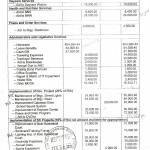BARANGAY CHAIRMAN
Doroteo A. Garsuta, Jr.
BARANGAY KAGAWADS
1. Emidio R. Barcinas Jr.
2. Luciano A. Jabines
3. Arlyn O. Dellosa
4. Tomas J. Garsuta Jr.
5. Julia B. Idulsa
6. Faustino M. Garsuta
7. Olimpio R. Villorejo
BARANGAY SECRETARY
Nerissa G. Gurang
BARANGAY TREASURER
Algerico C. Canencia
SK CHAIRPERSON
Patrice Jane D. Manuta
BARANGAY PROFILE:
Name of Barangay: CABAWAN
Number of Purok/Sitios: 8
Distance from Poblacion: 5 kilometers
Distance from Tagbilaran City: 11 kilometers
Total Land Area: 467.44 hectares
Total Population: 1,815
Number of Household: 429
Number of Families: 471
Number of Schools (Public): 1
Number of Catholic Chapels: 4
Length of Barangay Roads: 7 Kilometers
Source of Potable Water: Maribojoc Waterworks System; CACAWASA
Major Agricultural Product: Rice
Major Source of Livelihood: Nipa and Basket Weaving, Rice and Copra Farming, Fishing
Barangay IRA 2020: PhP 2,693,297.00
Number of BHWs: 6
Number of Tanods: 11
Number of Lupong Tagapamayapa: 9
Electrician: 1
BALA: 1
Number of Barangay Facilities: 7
LEGEND OF CABAWAN:
The name “CABAWAN” by its sound could easily be understood and interpreted by a mere Boholano individual. Through its given name, no one could ever argue of its own origin. If expounded one could just say that this barrio is known to be herding carabaos in the older times. It was first named as “COGON”.
Barangay Cabawan is also known for vast variety of “cogon grass” where abundantly grown in the area and where all kinds of animals especially carabaos are free to enjoy the grasslands. From then on, the place was changed from “COGON to CABAWAN”.
It was established in 1899 during American regime. On 1900 sitio Agahay transferred from Busao to Cabawan. But due to educational and political conflicts where to build the school in the barangay. In 1919 during the time of the former Municipal President Jose Jugo, sitio Agahay decided to establish their own barangay Agahay.
Barangay CABAWAN is composed of the following sitios after the separation of sitio Agahay:
Bato – due to organic rocks where the big cross was buried at the entry point on the 17th century to protect the people from moro pirates during Spanish colonization.
Basak – where vast grasslands and of rice fields are located and serve as the primary source of livelihood for the locals.
Pustan – where fisherman used to pack their catched fish and sell it to the people. Fishing is one of the primary source of living in the community.
Pangihan – due to its geographical location that is prone to flood.
Cabangcalan(Upper Cabawan) – where numbers of giant “bangkaw” trees are grown in place.
At present, 3 more sitios namely; Moto, Candasig and Lower Bato were added to compromise 8 puroks of barangay CABAWAN.
Moto – the highest peak with vast plains and has the largest number of population.
Candasig – geographically located along nipa swamps and the locals are abundant in terms of fishing and other livelihood. Candasig originally known as dasig which means lively.
Lower Pustan – (Purok 1) lower part of Pustan where nipa palms, and mangrove trees are known to be the home of different kinds of fish, clams, birds and even wild orchids.
From 1899 to 1953 barangay CABAWAN is headed by 61 tenientes, from the known families like: GARSUTA, DURAIN, ALMONTE AND JABINES.
At present the barangay is headed by the youngest generation of the Garsuta clan, the honorable Barangay Captain Doroteo Almeñe Garsuta Jr.





